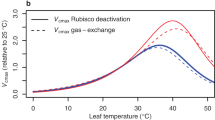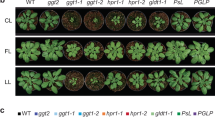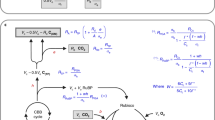Abstract
MOST plant species cannot show a net photosynthetic uptake of CO2 when the CO2 concentration of the surrounding atmosphere falls below about 50 p.p.m., because at this point photosynthetic carbon fixation is reduced by lack of substrate to the rate at which CO2 is being released from the plant by photorespiration. The concentration of CO2 at which this occurs is called the CO2 compensation point. A few species, including such important crop plants as Zea mays, have unusually low CO2 compensation points, typically near zero. Such plants may not photorespire, or alternatively may be capable of refixing all the photorespired CO2 by an unusually efficient photosynthetic mechanism.
This is a preview of subscription content, access via your institution
Access options
Subscribe to this journal
Receive 51 print issues and online access
$199.00 per year
only $3.90 per issue
Buy this article
- Purchase on Springer Link
- Instant access to full article PDF
Prices may be subject to local taxes which are calculated during checkout
Similar content being viewed by others
References
Kisaki, T., and Tolbert, N. E., Plant Cell Physiol., 11, 247 (1970).
Goldsworthy, A., Nature, 217, 62 (1968).
Zelitch, I., Physiological Aspects of Crop Yield (ASA and CSSA, Wisconsin, 1969).
Berry, J. A., Downton, W. J. S., and Tregunna, E. B., Canad. J. Bot., 48, 777 (1970).
Slack, C. R., Hatch, M. D., and Goodchild, D. J., Biochem. J., 114, 489 (1969).
Björkman, O., and Gauhl, E., Planta, 88, 197 (1969).
Rabson, R., Tolbert, N. E., and Kearney, P. C., Arch. Biochem. Biophys., 98, 154 (1962).
Forrester, M. L., Krotkov, G., and Nelson, C. D., Plant Physiol., 41, 428 (1966).
Bull, T. A., Crop Science, 9, 727 (1969).
Ongun, A., and Stocking, C. R., Plant Physiol., 40, 819 (1965).
Cheung, G. P., Rosenblum, I. Y., and Sallach, H. J., Plant Physiol., 43, 1813 (1968).
Zelitch, I., J. Biol. Chem., 233, 1299 (1958).
Wilson, A. T., and Calvin, M., J. Amer. Chem. Soc., 77, 5948 (1955).
Zelitch, I., and Walker, D. A., Plant Physiol., 39, 856 (1964).
Coombs, J., and Whittingham, C. P., Phytochemistry, 5, 643 (1966).
Ellyard, P. W., and Gibbs, M., Plant Physiol., 44, 1115 (1969).
Author information
Authors and Affiliations
Rights and permissions
About this article
Cite this article
GOLDSWORTHY, A., DAY, P. Further Evidence for Reduced Role of Photorespiration in Low Compensation Point Species. Nature 228, 687–688 (1970). https://doi.org/10.1038/228687a0
Received:
Issue Date:
DOI: https://doi.org/10.1038/228687a0
This article is cited by
-
Regulation of photorespiration in C3 and C4 species
The Botanical Review (1975)
Comments
By submitting a comment you agree to abide by our Terms and Community Guidelines. If you find something abusive or that does not comply with our terms or guidelines please flag it as inappropriate.



